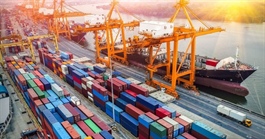Bullish export outlook ahead in spite of external woes
Bullish export outlook ahead in spite of external woes
Export prospects are proving upbeat despite several looming threats such as growth slowdowns in China’s economy and lingering input material shortages.

The latest international growth forecasts remain buoyant about rebound prospects for the global economy in 2022 that could help maintain high growth momentum for Vietnam’s export throughout the year.
The World Trade Organization’s latest report noted that the global trade volume would grow 4.7 per cent this year, slightly more than the 4 per cent hike in the previous forecast, and could resume pre-pandemic growth level late this year.
Logistics costs have begun to normalise since late last year on the back of high COVID-19 vaccination rates as well as marked improvement of container deficiencies following soaring orders for container production from mid-2021.
Lower transportation costs would also be instrumental in helping local businesses boost exports, particularly to the US and EU markets.
Deputy Minister of Industry and Trade Do Thanh Hai has delivered upbeat growth projections for Vietnam’s import-export business in the upcoming months, leveraging more inclusive and efficient implementation of free trade agreements between Vietnam and other active members in global trade.
These major deals are pushing up the penetration of Vietnamese exports into partners’ markets with preferential tariffs, thereby promising robust export growth.
The Ministry of Industry and Trade’s executive forecast has been grounded on the fact that, with textile and apparel export, a stable and high number of export orders show that local companies have been adaptive to doing business through diversification of export products and markets, as well as adaption to using fresh trading and payment schemes in current circumstances. Their increased investment into automation equipment and technologies is also one of the factors helping them to become more resilient to market pressures in quality and delivery terms.
“We have orders for export production until the end of the second quarter, in which several items have orders for the full year,” said Than Duc Viet, general director of Garment 10 Corporation – a major member of state-owned Vinatex.
Last year, Garment 10 still managed growth in both revenues and profit, with pretax profit surging 11 per cent and per capita average incomes rising 7.6 per cent on-year.
Aside from the positive factors, several major issues are posing a threat to Vietnam’s strong export rebound in 2022. A lack of sustainability from China – Vietnam’s key export market – is causing danger to Vietnam’s on-year export growth target, which is set at about 6-8 per cent for 2022.
By late last year, China was Vietnam’s top trade partner, holding 32.68 per cent of Vietnam’s total export value, and 16.82 per cent of Vietnam’s total import value. In addition, China was placed fourth among the largest foreign investors in Vietnam in 2021, at $2.92 billion in registered capital.
Last year, China’s earlier economic rebound was hindered by weakening consumption, tightened supervision rules, a real estate sector crisis, and strict pandemic-prevention policies. The country’s GDP expanded 8.1 per cent in 2021, yet successive pandemic outbreaks are eroding China’s strength.
Global markets are foreseeing a declining Chinese stock market and weakened growth of the economy in the second half of 2022, but the spillover effect may yet be less significant than currently feared. According to the International Monetary Fund, China’s GDP growth might slow down to 5.6 per cent on-year in 2022.
Analysts at VNDirect Securities have concerns that if the growth of China’s economy worsened more than market expectations, this could dampen Vietnam’s export prospects as well as affect investor sentiments in this country.
In addition, the shortage of input materials to serve export production is becoming increasingly imperative to Vietnam’s diverse export sectors.
According to Nguyen Quoc Anh, director of Duc Minh Rubber Company and chairman of Ho Chi Minh City Plastic Rubber Manufacturers Association, the thorny issue for businesses currently is not finding output markets, but that “rising material expenses have pushed up production costs”.
Anh quoted that since early 2021, the price of diverse materials, chemicals, and rubber production additives have soared 60 per cent, while it is proving extremely difficult for businesses to raise product prices as most contracts were signed earlier.
For new contracts, there were cases of businesses proposing price hikes of 5-10 per cent, with partners being hesitant and looking to wait for prices to go down before closing contracts, according to Anh.























